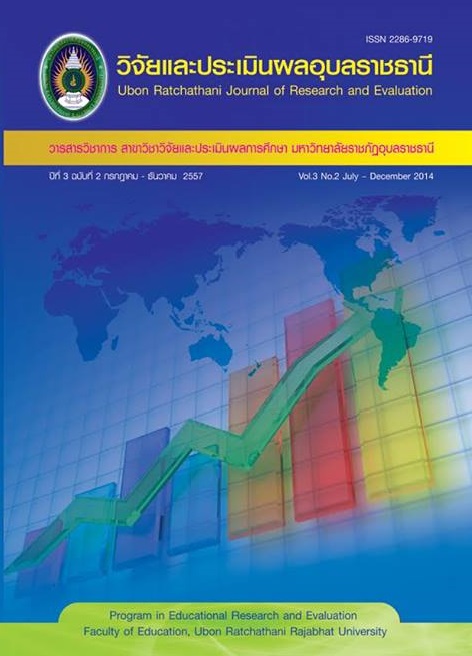การพัฒนาเครื่องมือการวัดและประเมินผลในชั้นเรียน กลุ่มสาระการเรียนรู้คณิตศาสตร์ตามแนวคิดของ Angelo and Cross 55-63
คำสำคัญ:
เครื่องมือ, การวัดและประเมินผลในชั้นเรียน, คณิตศาสตร์บทคัดย่อ
การวิจัยครั้งนี้มีวัตถุประสงค์เพื่อพัฒนาและหาคุณภาพของเครื่องมือการวัดและประเมินผลในชั้นเรียนตามแนวคิดของ Angelo and Cross กลุ่มสาระการเรียนรู้คณิตศาสตร์ ตัวอย่างที่ใช้ในการวิจัยครั้งนี้ เป็นนักเรียนชั้นประถมศึกษาปีที่ 6 สำนักงานเขตพื้นที่การศึกษาประถมศึกษาอุบลราชธานี เขต 2 ในภาคเรียนที่ 1 ปีการศึกษา 2556 จำนวน 359 คน ได้มาโดยวิธีสุ่มแบบหลายขั้นตอน เครื่องมือที่พัฒนาใช้เทคนิคการประเมินผลในชั้นเรียนของ Angelo and Cross 4 เทคนิค คือ การรับรู้ปัญหา การวางแผนในการแก้ปัญหา การแก้ปัญหาจากเอกสาร และการแสดงผลย้อนกลับเพื่อตรวจสอบคำตอบ เรื่อง การแก้โจทย์ปัญหาการบวก ลบ คูณ หาร สำหรับนักเรียนชั้นประถมศึกษาปีที่ 6 และแบบสังเกตพฤติกรรมการแสดงออกในการเรียนรู้ การวิเคราะห์ข้อมูล ได้แก่ 1) สถิติพื้นฐาน คือ ค่าเฉลี่ย ส่วนเบี่ยงเบนมาตรฐาน 2) วิเคราะห์หาคุณภาพเครื่องมือ คือ ความเที่ยงตรงเชิงเนื้อหา ความยาก อำนาจจำแนก และค่าความเชื่อมั่น
ผลการวิจัยพบว่า
- คุณภาพของแบบทดสอบชนิดเติมคำ ทั้ง 4 ชุด มีค่าความเที่ยงตรงเชิงเนื้อหาสูงกว่าเกณฑ์ทุกข้อ ค่าความยากตั้งแต่ 0.20 - 0.77 และค่าอำนาจจำแนกตั้งแต่ 0.21 - 0.94 ซึ่งพบว่า ข้อสอบทุกข้อมีคุณภาพตามเกณฑ์
ที่กำหนด มีค่าความเชื่อมั่นเท่ากับ 0.91, 0.91, 0.92 และ 0.91 ตามลำดับ - คุณภาพของแบบสังเกตพฤติกรรมการแสดงออกในการจัดการเรียนรู้ มีค่าความสอดคล้องตั้งแต่ 0.60 ถึง 1.00 และมีค่าความเชื่อมั่นเท่ากับ 0.83
เอกสารอ้างอิง
พิสณุ ฟองศรี. การสร้างและพัฒนาเครื่องมือวิจัย. กรุงเทพฯ : ด่านสุทธาการพิมพ์, 2552.
ยุพิน พิพิธกุล. การเรียนการสอนคณิตศาสตร์. กรุงเทพฯ : บพิธการพิมพ์, 2539.
ล้วน สายยศ และอังคณา สายยศ. เทคนิคการวิจัยทางการศึกษา. พิมพ์ครั้งที่ 3. กรุงเทพฯ : สุวีริยาสาส์น, 2543.
. สถิติวิทยาทางวิจัย. พิมพ์ครั้งที่ 3. กรุงเทพฯ : สุวีริยาสาส์น, 2540.
วิชาการ, กรม. แนวทางบริหารการจัดหลักสูตรตามหลักสูตรแกนกลางการศึกษาขั้นพื้นฐาน พุทธศักราช 2551. กรุงเทพฯ : โรงพิมพ์คุรุสภาลาดพร้าว, 2551.
ศึกษาธิการ, กระทรวง. แนวปฏิบัติการวัดและประเมินผลการเรียนรู้ ตามหลักสูตรแกนกลางการศึกษาขั้นพื้นฐาน พุทธศักราช 2551. พิมพ์ครั้งที่ 3. กรุงเทพฯ : โรงพิมพ์ชุมชนสหกรณ์การเกษตรประเทศไทย จำกัด, 2554.
สมเดช บุญประจักษ์. คู่มือการสอนโครงงานคณิตศาสตร์. พิมพ์ครั้งที่ 8. กรุงเทพฯ : เมทกรุ๊ฟพระนคร, 2550.
สมนึก ภัททิยธนี. การวัดผลการศึกษา. พิมพ์ครั้งที่ 8. กาฬสินธุ์ : โรงพิมพ์ประสานการพิมพ์, 2555.
สุฐิยา เพชรวงษ์. การพัฒนาแบบทดสอบวัดปฏิบัติคณิตศาสตร์ ระดับชั้นมัธยมศึกษาตอนต้น. วิทยานิพนธ์การศึกษามหาบัณฑิต มหาวิทยาลัยนเรศวร, 2545.
Angelo, Thomas and Cross, Patricia. Classroom Assessment Techniques : A Handbook for College Teachers. 2rd ed. San Francisco : Jossey - Bass Publishers, 1993.
ดาวน์โหลด
เผยแพร่แล้ว
รูปแบบการอ้างอิง
ฉบับ
ประเภทบทความ
สัญญาอนุญาต
1. บทความที่ตีพิมพ์ในวารสารนี้ได้มีการตรวจสอบการลอกเลียนงานวรรณกรรมแล้ว ไม่เกินร้อยละ 25
2. บทความที่ตีพิมพ์ในวารสารนี้เป็นข้อคิดเห็น ข้อค้นพบของผู้เขียนบทความ โดยผู้เขียนบทความต้องเป็นผู้รับผิดชอบต่อผลทางกฎหมายใด ๆ ที่อาจเกิดขึ้นจากบทความนั้น ๆ
3. บทความ ข้อมูล เนื้อหา รูปภาพ ฯลฯ ที่ได้รับการตีพิมพ์ในวารสารวิจัยและประเมินผลอุบลราชธานี ถือเป็นลิขสิทธิ์ของวารสารวิจัยและประเมินผลอุบลราชธานี หากบุคคลหรือหน่วยงานใดต้องการนำทั้งหมดไปเผยแพร่ต่อหรือเพื่อกระทำการใดๆ จะต้องได้รับอนุญาตเป็นลายลักษณ์อักษรจากวารสารวิจัยและประเมินผลอุบลราชธานีก่อนเท่านั้น และจะต้องมีการอ้างอิงวารสารวิจัยและประเมินผลอุบลราชธานี ฉบับนั้น ๆ ด้วย






